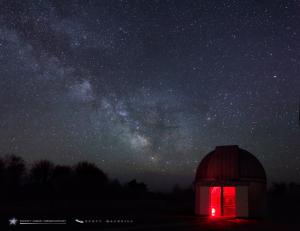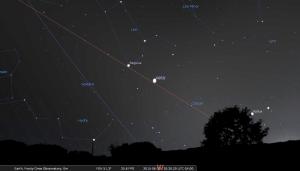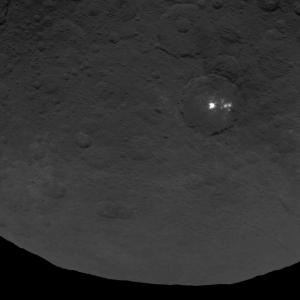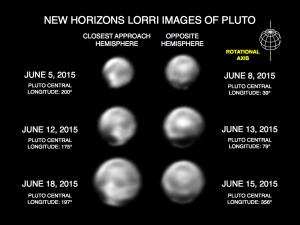
Public Stargazing
- Where:
- Frosty Drew Observatory
- When:
- Friday June 26, 2015 at 6:00 p.m.
- Cost:
- $1 Suggested Donation per Person
Tonight's forecast is calling for partly cloudy skies becoming clear over night with a chance of fog. The 71% waxing gibbous Moon will be with us until near 2:00 a.m. and will significantly brighten up the night skies over Frosty Drew. Additionally, Jupiter and Venus will be closing in on each other as we approach their fabulous conjunctions on June 30th when Jupiter will be within 0.3° of Venus making for a striking view. If clouds and fog can stay out, tonight will be a great night, even considering the presence of the bright gibbous Moon.
We plan to open the Observatory and Sky Theatre at 6:00 p.m. with live views of the solar photosphere and the massive departing sunspot 2371, which was responsible for the fabulous Aurora Borealis that mesmerized North America this past week. If skies are too cloudy at that time for the Sun, we will showcase archived views of the photosphere from previous solar viewing nights. The Nature Center will be open from 7:00 – 10:00 p.m. with Naturalists on hand to answer questions and showcase the daytime side of Frosty Drew. Once the Sun sets we will direct our telescopes towards the night sky. On display will be Venus which has waned into a stunning 37% crescent, Jupiter with all four Galilean Moons in view, the Moon which will be showing off fabulous views of Copernicus Crater; Tycho Crater and more, and Saturn which is just freaking awesome! We will stay on site until at least 11:30 p.m. and possibly later depending on sky conditions. In the Sky Theatre a slide show of astrophotos shot at Frosty Drew Observatory will be on display with commentaries.
Overall, tonight's weather is looking a bit more promising than the usual disaster we have been dealing with since the end of winter. Clearer skies will allow for excellent views of the planets and Moon, with a special emphasis on Saturn which is stunning to view in the Frosty Drew telescope. Though the 71% gibbous Moon will be bright and will obscure views of the phenomenal Milky Way, the cratered surface of the Moon will be in an excellent viewing position and will certainly mesmerize all. So stop in tonight, shake off those cloudy nights and have a fabulous night under the stars and become acquainted with that astro-enthusiast just waiting to spring out.
-------------------------------------------------------------------------
Weekly Happenings
Scott MacNeill
On June 30, 2015 step outside about 30 minutes after sunset to catch a stunning view of the mega close conjunction of Jupiter and Venus. Over the next few nights, Jupiter will continue to move further West along the ecliptic (the path the Sun and the planets take through the sky) appearing to come closer to Venus every night. This coming Tuesday, they will appear at their closest point, which is about 20 arc minutes (60 arc minutes in 1 degree). This is ridiculously close, so close that they will appear together in a telescope's field of view, so close that you can block both planets with just the width of your pinky finger extended to arms length. So get out for an astro-fix and check out the awesome conjunction!
The NASA Dawn mission just keeps rocking socks! With new imagery coming in almost daily, we are getting a fabulous view of the surface of Ceres, the closest dwarf planet to Earth. Just this week, new images of the mysterious white spots on Ceres surface were posted and the resolution is mind-blowing! This time last year our only view of Ceres was an image of a blurry blob with a bright blurry white spot, now we see the cratered surface of the fabulous dwarf planet with all the mysteries coming into light. So what is the mysterious white spots? Well they are clearly reflecting near 100% of sunlight. This leads us to hypothesize these regions as either surface bound ice or salt. Additionally, new imagery has revealed a mysterious pyramid like peak in an otherwise flat region of Ceres. Regardless, we are certain that what we are seeing is awesome! Keep up with the adventure and get addicted to Dawn with the rest of us astro-geeks at the NASA Dawn mission page
The count down is on to July 14, 2015, the day when we get our first ever close up view of Pluto, the most popular, and rather infamous, dwarf planet in the Solar System. The NASA New Horizons spacecraft has been traveling for near a decade for this moment. Nearly every few days, new images are coming in from New Horizons of Pluto and its large moon, Charon. We are already seeing many surprise features, like a super dark polar region on Charon, potential ice caps on Pluto, and the dramatic barycenter (center point of gravity, that gravitationally bound bodies will orbit) that Charon and Pluto create. Color images are periodically coming in and the anxiety of the July 14th flyby is mounting. Dive into the adventure to Pluto at the NASA New Horizons Page
-Scott



